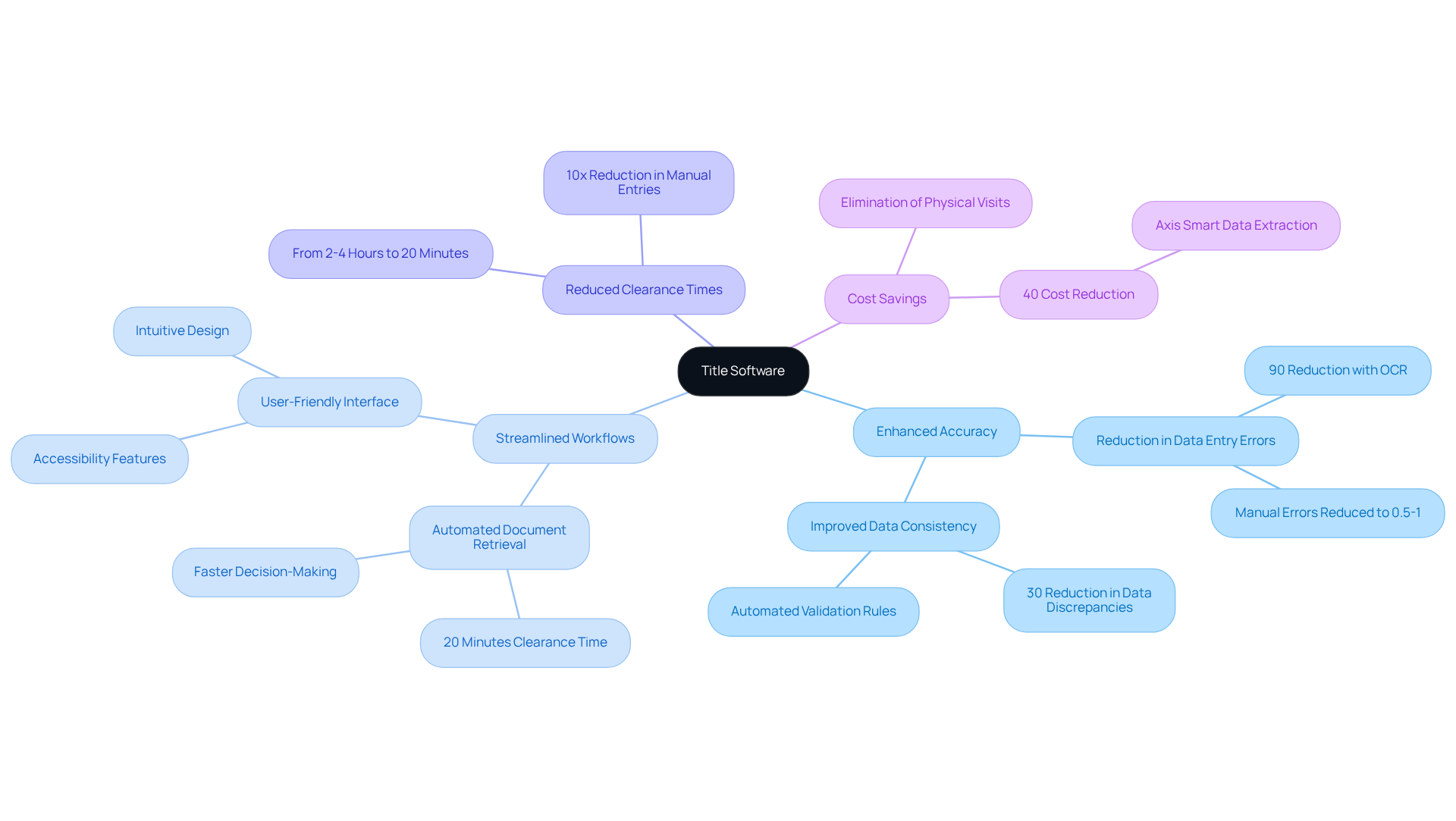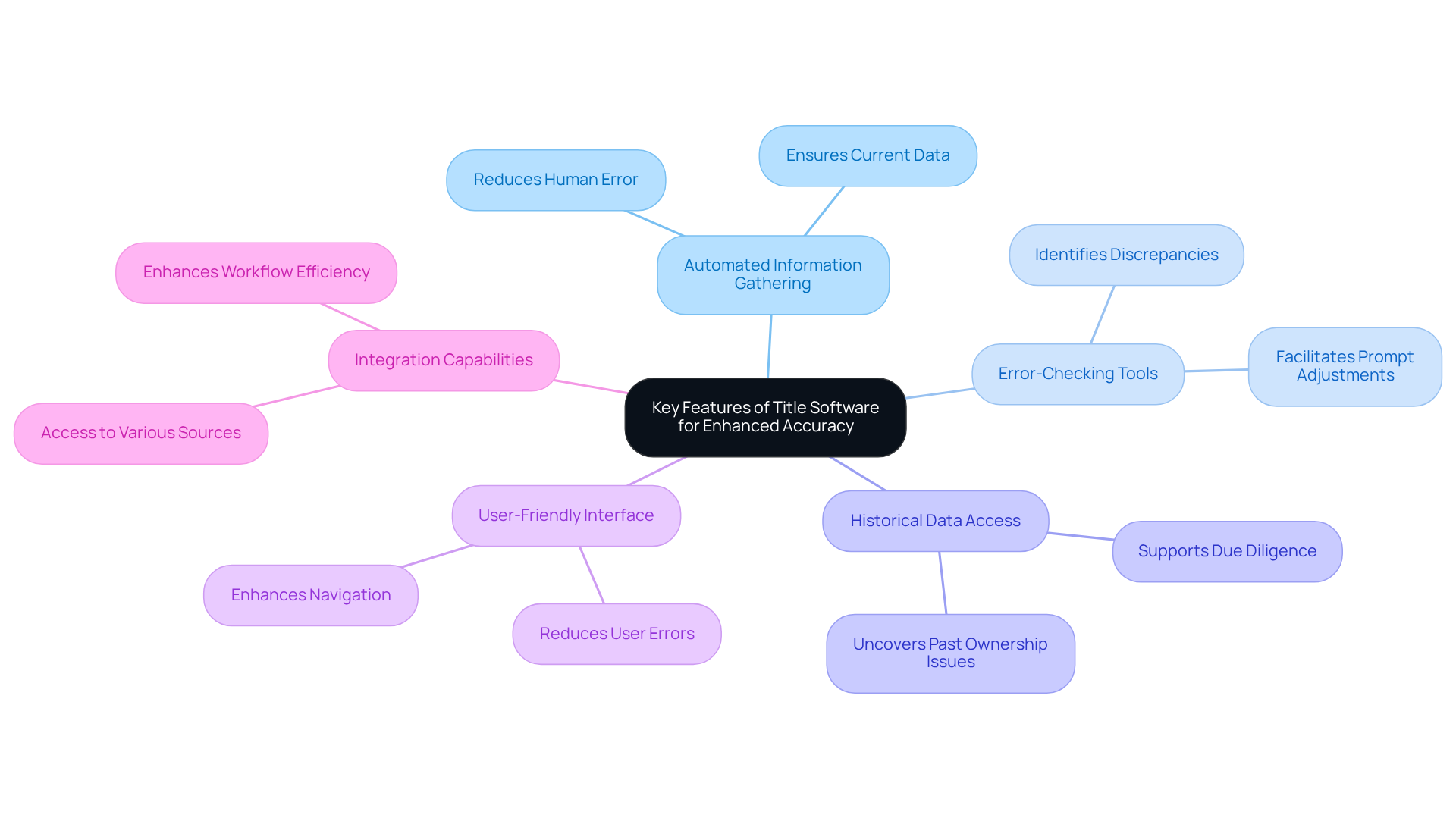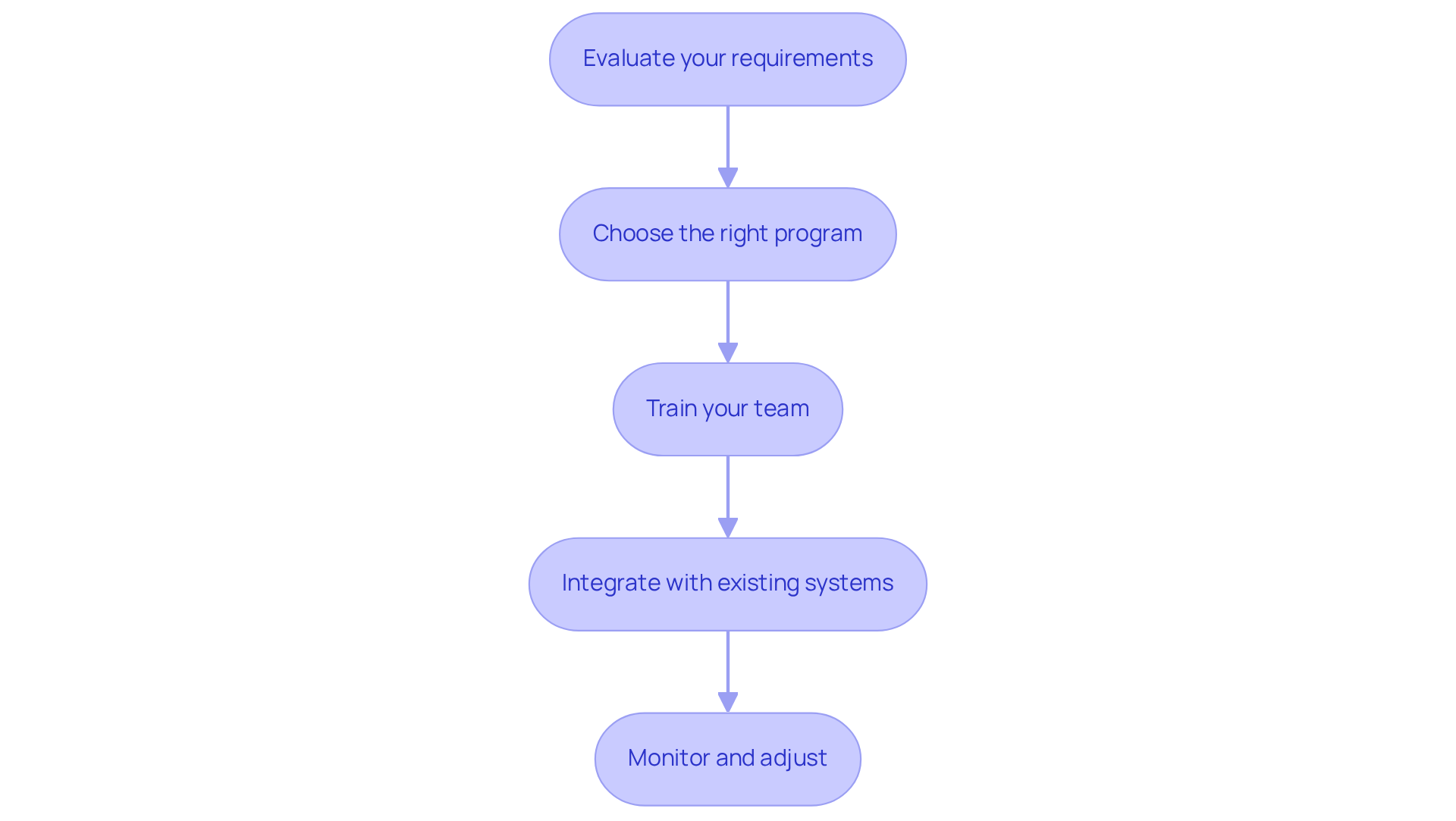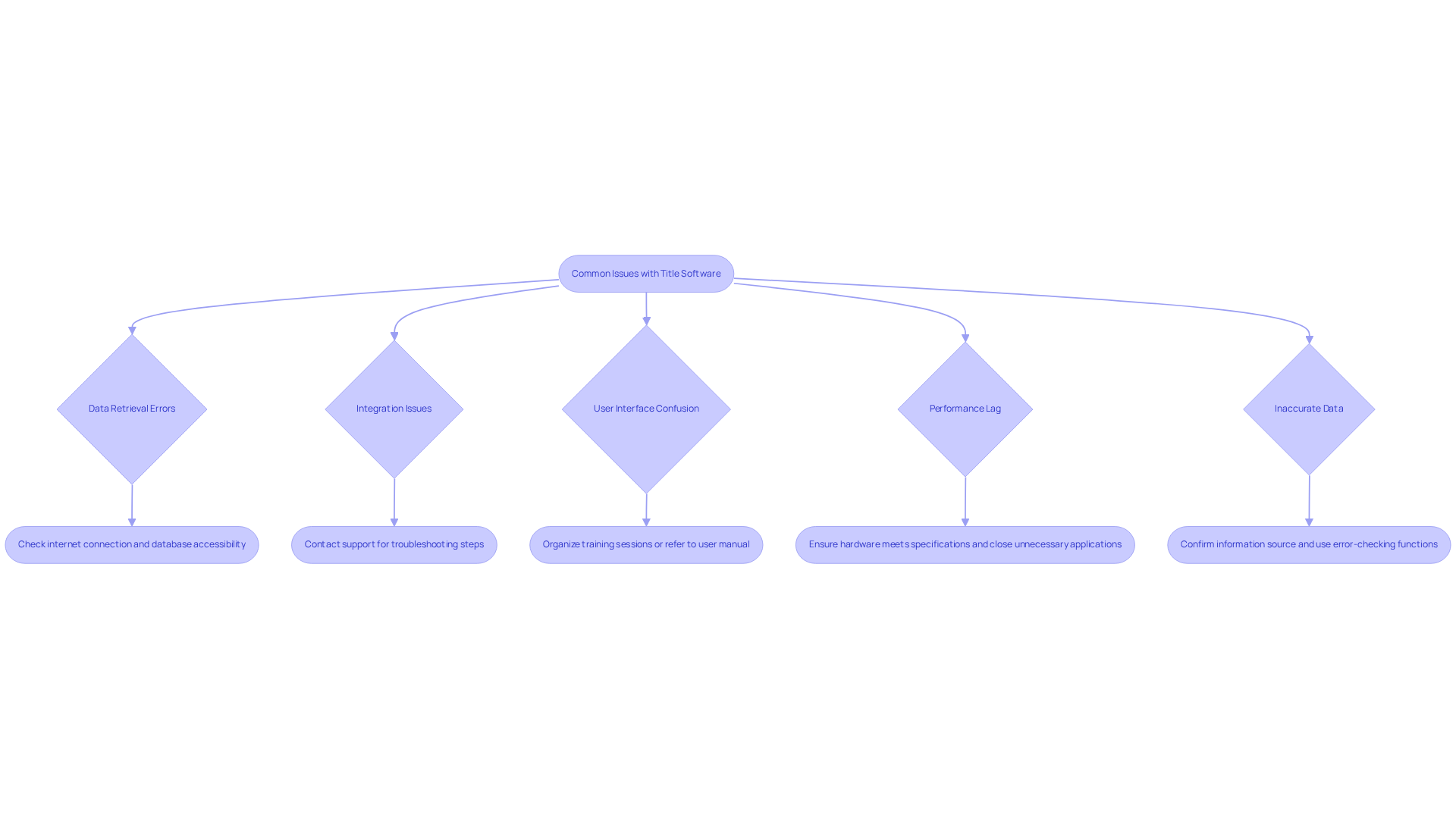Overview
Title software significantly enhances accuracy in research by automating data gathering, integrating error-checking tools, and providing access to historical records. These features collectively reduce human error and improve the reliability of property ownership information. Furthermore, the article illustrates how these capabilities not only streamline workflows and ensure compliance but also lead to substantial cost savings. This demonstrates the software's vital role in effective title research, reinforcing its importance in the industry.
Introduction
The landscape of property ownership research has evolved dramatically with the introduction of title software—an essential tool that streamlines workflows and enhances accuracy in data management.
By leveraging advanced technologies such as machine learning and optical character recognition, this software minimizes human error and ensures compliance with legal standards.
Consequently, it has become indispensable for insurance professionals and real estate experts alike.
However, as organizations adopt these tools, critical questions arise:
- How can title software truly transform research accuracy?
- What key features drive this improvement?
Exploring these aspects not only reveals the benefits but also uncovers the challenges associated with integrating such technology into existing workflows.
Understand Title Software and Its Importance in Title Research
The title management application serves as a crucial asset in enhancing property ownership research, effectively streamlining the acquisition and examination of public documents. This advancement significantly reduces the time and effort typically required for manual inquiries. By harnessing cutting-edge technologies such as machine learning and optical character recognition (OCR), the application showcases how title software improves accuracy in data extraction, minimizes human error, and ensures compliance with legal standards.
For insurance professionals, adopting ownership-related software is indispensable. It not only streamlines workflows but also shows how title software improves accuracy by mitigating risks associated with defects and inaccuracies in property ownership records. The implementation of automated systems has resulted in a dramatic reduction in clearance times, shrinking them from 2-4 hours to just 20 minutes, thereby illustrating the efficiency gains achievable.
Furthermore, expert insights emphasize that leveraging such technology can yield substantial cost savings. A title industry analytics company reported a remarkable 40% reduction in costs through automated data extraction solutions. This underscores the application’s vital role in the competitive landscape of real estate.

Explore Key Features of Title Software for Enhanced Accuracy
When assessing title software, several essential features can significantly improve research accuracy:
-
Automated Information Gathering: Title software employs automated information gathering to extract details from reliable databases, ensuring that the content remains both current and comprehensive. This capability not only simplifies the research process but also mitigates the risk of human errors, which is critical given that manual information collection can exhibit an error rate of 3-4%. In contrast, automated systems can drastically reduce this error rate, thereby enhancing overall accuracy.
-
Error-Checking Tools: Integrated validation mechanisms are crucial for identifying discrepancies and errors within record titles. These tools facilitate prompt adjustments, thereby improving the overall dependability of the information.
-
Historical Data Access: Access to historical property records is invaluable for uncovering past ownership issues and liens. This feature enables researchers to conduct thorough due diligence, which is essential for ensuring clear property ownership.
-
User-Friendly Interface: A well-designed interface enhances navigation, thereby reducing the likelihood of user errors. This is particularly significant in a field where accuracy is paramount, as even minor mistakes can lead to considerable legal and financial repercussions.
-
Integration Capabilities: The ability to seamlessly integrate with other tools and databases is vital for enhancing workflow efficiency. This interoperability ensures that investigators can access and utilize information from various sources, further improving information precision and study results.
By incorporating these features, title software showcases how title software improves accuracy in research and aids real estate professionals in making informed decisions, ultimately leading to more effective and trustworthy management. Furthermore, employing automated data gathering can result in substantial cost reductions compared to conventional methods, underscoring the importance of adopting such technologies in document analysis.

Implement Title Software in Your Research Workflow
To utilize naming applications efficiently in your study process, follow these steps:
- Evaluate your requirements. Determine particular obstacles in your existing research procedure that the program can resolve.
- Choose the right program. According to your requirements, select a suitable application that provides the features mentioned previously.
- Train your team. Provide comprehensive training for your team to ensure they are comfortable using the new application.
- Integrate with existing systems. Ensure that the application connects seamlessly with your current systems to avoid disruptions.
- Monitor and adjust. After implementation, continuously observe the system's performance and collect feedback from users to make necessary modifications for optimal efficiency.

Troubleshoot Common Issues with Title Software
Even the most advanced title applications can present challenges for users. Here are some prevalent issues along with effective solutions:
-
Data Retrieval Errors: When the application fails to retrieve data, first check your internet connection and confirm that the databases are accessible. Statistics indicate that connectivity issues account for approximately 66% of retrieval errors, emphasizing the importance of a stable network.
-
Integration Issues: If the application struggles to connect with existing systems, reach out to the support team for customized troubleshooting steps. Expert opinions suggest that understanding the specific integration requirements can often resolve these conflicts efficiently. As pointed out by Donald Knuth, 'Quality is not an act, it is a habit,' emphasizing the significance of upholding high standards in system integration.
-
User Interface Confusion: Users may find the interface challenging to navigate. In such cases, consider organizing additional training sessions or referring to the user manual for guidance. Research shows that proper training can reduce user errors significantly, enhancing overall productivity. A case study on troubleshooting common issues with automated systems found that targeted training improved user satisfaction by 40%.
-
Performance Lag: If the application experiences slow performance, ensure that your hardware meets the application's specifications. Closing unnecessary applications can free up resources, improving speed. Data indicates that performance issues are often linked to hardware limitations, making this a critical area to address. A study on application performance revealed that 75% of users experienced improved speed after optimizing their hardware setup.
-
Inaccurate Data: Inaccuracies can arise from various sources. To alleviate this, confirm the information source and employ the software's integrated error-checking functions to detect inconsistencies. Studies have shown how title software improves accuracy by implementing systematic checks, which can reduce data inaccuracies by up to 30% and ensure more reliable outcomes in title research.

Conclusion
The integration of title software into research processes fundamentally transforms the management and analysis of property ownership data. By leveraging advanced technologies, this software enhances research accuracy and streamlines workflows, ultimately leading to more reliable outcomes in the real estate sector.
Key features of title software—such as automated information gathering, error-checking tools, and historical data access—significantly mitigate human error and ensure compliance with legal standards. These advancements yield remarkable efficiency gains, reducing clearance times and lowering operational costs. Furthermore, the implementation of user-friendly interfaces and integration capabilities fosters a smoother research experience, empowering professionals to make informed decisions with confidence.
Embracing title software is not merely a technological upgrade; it is a strategic move towards enhancing accuracy and reliability in property research. As the real estate landscape continues to evolve, adopting such innovative solutions will be crucial for professionals aiming to stay competitive. Investing in title software not only improves research outcomes but also safeguards against potential risks, making it an essential tool for success in the industry.
Frequently Asked Questions
What is title software and why is it important?
Title software is a title management application that enhances property ownership research by streamlining the acquisition and examination of public documents. It reduces the time and effort needed for manual inquiries and improves accuracy in data extraction.
How does title software improve accuracy in data handling?
Title software utilizes advanced technologies such as machine learning and optical character recognition (OCR) to minimize human error and ensure compliance with legal standards, thus improving the accuracy of data handling.
What benefits does title software offer to insurance professionals?
For insurance professionals, title software streamlines workflows and mitigates risks associated with defects and inaccuracies in property ownership records, making it an indispensable tool.
How has the implementation of title software affected clearance times?
The implementation of automated systems in title software has dramatically reduced clearance times from 2-4 hours to just 20 minutes, showcasing significant efficiency gains.
What cost savings can be achieved by using title software?
Leveraging title software can yield substantial cost savings, with reports indicating a 40% reduction in costs through automated data extraction solutions in the title industry.




